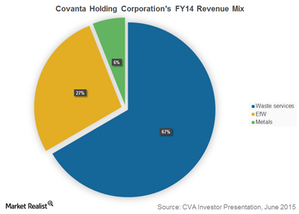An Overview of Covanta Holding’s Business Model
Covanta Holding Corporation (CVA) generates revenues through waste collection and services, energy from waste, and metal recycling.
June 30 2015, Updated 1:07 p.m. ET

Covanta’s business model
Covanta Holding Corporation (CVA) generates revenues in three ways:-
- waste collection and services
- energy from waste
- metal recycling
Waste collection and services
Waste collection and services is the biggest revenue generator for Covanta with more than 66% of its revenues coming from the segment. About 85% of the segment’s revenues are generated from contracts with municipalities. This is also the most competitive segment with larger players such as Waste Management (WM), Waste Connections (WCN), and Republic Services (RSG) competing for market share. In fiscal 2014, the segment generated $1,030 million in revenues. Municipalities pay the company for collecting and transporting solid waste.
Energy from waste
Covanta is an American leader in energy from waste (or EfW) with 46 EfW facilities and about 20 million tons of waste processed annually. The company has electricity generation capacity of more than 1,500 megawatts (or MW) and produces more than 10 million megawatt hours (or MWh) of electricity annually. That’s enough to power about a million average households.
Most of the company’s EfW facilities are located in the northeast United States around densely populated metropolitan areas. The electricity is sold at high demand centers. About 27% of the company’s fiscal 2014 revenues came from this segment. More than 80% of the segment’s electricity output is contracted or hedged, providing stable cash flows. Since Covanta utilizes collected waste for electricity generation, it effectively gets paid for the fuel. Covanta is part of the iShares Russell 1000 Growth ETF (IWF).
Metal recycling
From the residual waste left after combustion, Covanta produces recycled ferrous and non-ferrous metals and sells them on the market at spot prices. While not a large revenue contributor, the fact that the metals are extracted from the waste makes it a low-cost, high-margin segment.
